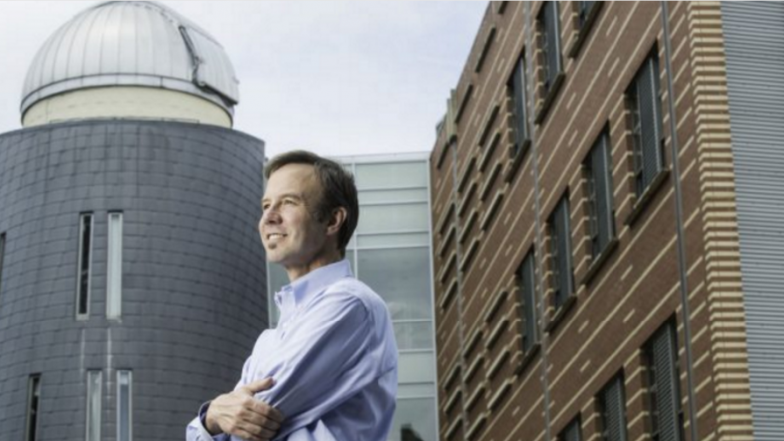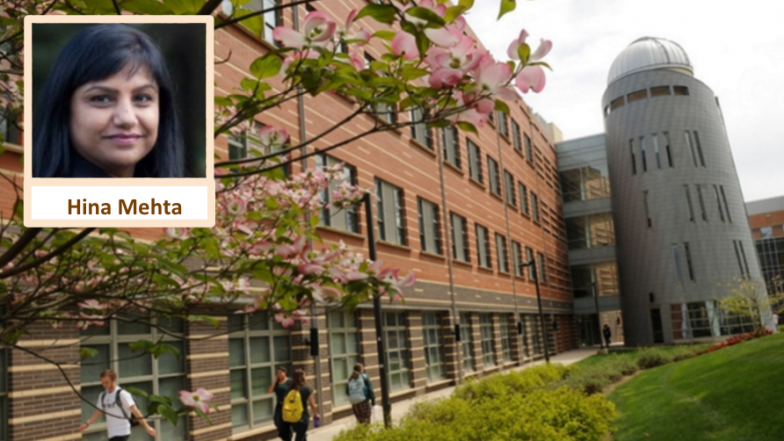Information
Webpage: techtransfer.gmu.edu/
Email: ott@gmu.edu
Phone: (703) 993-8933
Fax: (703) 993-9710
Address: Office of Technology Transfer
George Mason University
Research Hall, 359, Fairfax Campus
Fairfax, VA 22030
Forms
People
Hina Mehta
Interim Director
703-993-3879 hmehta4@gmu.edu
Jacquie Prather Marketing Analyst 703-993-4103 ott@gmu.edu
Gloria Garcia Administrative Assistant 703-993-8933 ggarcia3@gmu.edu
Articles
Technology Transfer
Patriot Entrepreneur | Winter 2007
Article 1 – The Office of Technology Transfer at Mason
 Jennifer Murphy and the Technology Transfer staff.
Jennifer Murphy and the Technology Transfer staff.Pictured from left: David Grossman, Patent Agent /
Licensing Associate; Murphy; David Yee, Patent Agent;
and Joe Janda, Life Sciences Licensing Associate.
Not pictured: Gloria Garcia
The first article in our series on technology transfer will examine the Technology Transfer Office at George Mason University. Recently, we caught up with the Assistant Vice President for Research and Economic Development and George Mason’s Director of Technology Transfer, Jennifer Murphy. Jennifer started the Office of Technology Transfer at Mason and has seen a steady growth in invention disclosure activity, patents issued, and commercialization opportunities. Jennifer and her staff regularly meet with faculty to learn more about their scholarship at Mason, and the potential commercial applications of those discoveries.
Why are universities engaged in technology transfer?
Increasingly technology transfer offices are being recognized as central to the overall mission of the university research enterprise. Of course every university engaged in technology transfer hopes to create revenue that it can recycle to support further research within the institution. But, in fact, revenue is not the real driving factor. Rather, there are other, non-financial reasons to support technology transfer that can arguably be considered more critical to the institution’s overall goals. To begin, tech transfer is now recognized as an important avenue for disseminating research results. Traditionally, research outcomes are disseminated through publications in scholarly journals, but today, technology transfer efforts translate research results into tangible products and services so that those very results can benefit the public in substantial ways. Technology transfer also gives institutions further means to attract and retain a highly motivated and bright faculty. Most institutions share all net proceeds from commercialization with the inventors. We, at George Mason, share 50% of our tech transfer revenue. That kind of financial reward can be very important to a faculty member’s choice of institution. Finally, technology transfer promotes the university’s interaction with its community through economic development activities. Increasingly, universities are engaging in creating start up companies around their technologies, bringing investment dollars and jobs to the areas in which the university resides.

How does your office reach out to faculty researchers?
We regularly schedule two open training sessions each year. These events focus on the university’s efforts in technology transfer, university policies governing intellectual property ownership and include a patent primer. We also visit regularly scheduled department faculty meetings where we can be more specific about issues particular to a given discipline. Finally, we have recently started an “Open House” every Friday where faculty can sign up to spend an hour or so with several of the Tech Transfer staff and brainstorm their new ideas.
How does your office identify potential investors of university technology?
There are three distinct sources of potential interest in the commercialization of university technologies. The first of these, and perhaps the most obvious, are existing companies that might be interested in licensing in the technology to create a new product line or enhance a current product or service. Finding these companies and good contacts can be challenging. Typical tools include conducting market research to identify the players and then searching through web sites to get to the right people. The second group is the Angel and early stage VC community that can see the potential of a technology as a start up company. Usually we find these individuals at networking events and then invite them to the university to look at specific technologies. Networking events are the means of reaching out to the third group – namely entrepreneurs. While they generally do not have cash resources to invest, they do invest a huge amount of human capital in getting technologies to market. Their energy and hard work are critical to the success of many commercialization efforts
“We need funds to cover the costs of the many patent applications we are filing. We have a prolific group of inventors at George Mason who are making important breakthroughs in areas ranging from cancer diagnostics to network security.”
—Jennifer Murphy, Director of Technology Transfer Office at GMU
Why do you think people in the business community often criticize Tech Transfer offices as being difficult to work with in transferring technology out to commercial entities?
Interestingly, I have heard this comment before, but I have never experienced it, so I can really only speculate as to its origin. My initial guess is that it may have come from the decade of the 90’s when most tech transfer offices were being asked to be self sustaining. Naturally, then, those operations would often ask for high up front fees in order to ensure an immediate cash intake, rather than sharing the risk with the commercial entity by asking for a low up front fee and perhaps a slightly higher royalty rate where everyone gains from a successful product. I would like your readers to know that we very much ascribe to the latter model at Mason. Another issue that may contribute to some of the “negative” perceptions of the business community – especially the Angels and VC’s is a misalignment of expectations with regard to the “state” of university technologies. Because of the faculty imperative to publish or perish, inventions are often disclosed early in their development so that patent applications can be filed and then publications submitted to scholarly journals. At universities, then, we have a lot of very early stage technologies that often don’t even have a working prototype. I do believe, though, that more and more the business community is beginning to understand the university environment and that this misalignment of expectation is beginning to disappear.
Describe some of the ways that you are currently exposing University technology/research to the business community?
Of course we maintain our website (http://techtransfer.gmu.edu) where anyone can look at our available technologies. However, we also attend trade shows where we think there may be a community of interested companies or investors. Recently, of course, we have been fortunate to be able to feature a “technology of the month” in this Newsletter. Finally, we are very excited about a non-life science EXPO that ALCOVe (the Academic Licensing Community of Virginia) will be hosting on May 22. Inventors and researchers along with the staff of the Commonwealth’s tech transfer offices and several federal labs will present their technologies at George Mason. We will have more on this event in the next Patriot Entrepreneur.
We know you assist faculty and staff with their inventions. Do you also work with student inventors?
Yes, we will handle (i.e., pay for patenting costs and marketing the technology) if a student has an invention that he or she would like the university to manage, and the Tech Transfer staff believes the technology has commercialization potential. In such cases, the student assigns the invention to the university and we share 50% of all proceeds after patent costs with the student, just as we do with faculty and staff.
What are the three most pressing needs of your office?
We urgently need funding to pay for three specific needs:
- We need funds to cover the costs of the many patent applications we are filing. We have a prolific group of inventors at George Mason who are making important break throughs in areas ranging from cancer diagnostics to network security. These costs do often get reimbursed when the technologies are licensed, but the initial up front cost comes from our budget.
- We need a prototyping fund so that when the invention comes to us at an early stage, we will have a source of money to get the prototype created or get the proof of concept taken the one or two steps further that are needed to convince the commercial sector of the viability of the technology. The use of funds might include animal studies in the life science area, software coding to implement algorithms, implementing cores on a chip and testing them, etc. This need is now the focus of a new effort to create a gift fund to which alumni and the business community can contribute and actually see very specific results of their donations. I hope we can talk more about this opportunity in the next Patriot Entrepreneur.
- Finally, we need funding for additional personnel to license our technologies. We have found in benchmarking studies that there is a strong correlation between the number of licensing personnel in a tech transfer office and the income of the office. As commercialization successes grow and income begins to accrue to our tech transfer efforts, we will be able to solve many of the patent and prototyping funding challenges I have just mentioned.
The Invention to Innovation Project
Patriot Entrepreneur | Spring 2007
Article 2 – Assistant Vice President for Regional Economic Development, Jerry Coughter

Jerry Coughter, Assistant
Vice President for
Regional Economic
Development, George
Mason University
The second article in our series on technology transfer examines the new ‘Invention to Innovation” Project. The goal of the project is to move disclosed or patented IP at George Mason University closer to commercialization, making it more attractive for licensing or company formation. We recently caught up with the Director of the Invention to Innovation Project, Jerry Coughter. Mr. Coughter is the Assistant Vice President for Regional Economic Development at George Mason University:
Why did the University create the Invention to Innovation Project? Couldn’t we just tap into the CIT Gap Fund?
The Invention to Innovation Project is designed to address a situation that occurs at the earliest stage in the commercialization path of a technology, when the invention has been disclosed to the Tech Transfer Office, but before it is ready to be commercialized. Even the most promising technologies generally require some additional work to make them attractive to investors or licensees. This was a problem I saw frequently when I worked at CIT – investors typically aren’t interested in technologies, they’re interested in businesses. So when we hosted events to connect inventors to investors, it was very difficult to make any matches. The I to I Project will work to develop promising university inventions at the “pre-company” or “pre-investment” stage, with goal of getting them to a point where an investor might be interested in starting a business around one of them or a company might be interested in licensing one of them. The mission of the CIT GAP Fund is to help early stage companies reach a point where they can attract outside financing, so it’s very complementary to our Project. If I to I helps an invention become an innovation around which a company is formed, that new company can look to the CIT GAP Fund for assistance down the road.
Are there not any resources locally or regionally available that can assist early stage researchers in commercializing their work?
Not really. There are resources available once a company is formed, especially if that business has revenue or the promise of revenue in the near future. The types of inventions we’re talking about are a long way from becoming revenue-producing. On occasion it is possible to find companies or investors who will take on very early stage technologies, but because of the high degree of risk involved, they do it only with financial terms that are very favorable to them and not at all favorable to the university or the inventor.
How will you utilize the money that is raised for this project?
Remember that the goal of I to I is to push inventions further up the pathway to commercialization; different activities will occur at different steps along that path. Also, different types of inventions will require different sorts of services, but in no case will we be funding additional basic research. In general, support will be divided into two phases. In the Evaluation Phase $2500 to $5000 might be spent to make a preliminary case (perform a market analysis, determine adoption drivers, investigate risk factors, etc.) for further development of the technology. Completion of the Evaluation Phase might include preliminary product or prototype specifications and a description of critical success factors and prospects for funding. In the Investment Phase up to $50,000 may be devoted to develop a working prototype, fund pre-clinical development, or prepare a detailed development plan. In either case, it is expected that a successful licensing event would result in the fund recouping its investment.
How will you identify the areas of research at Mason that really need this kind of assistance?
The I to I Project is completely agnostic as to types of inventions that will be supported; they may come from any faculty, staff or student in any department at Mason. The first step in the process occurs when the invention is disclosed to the tech transfer office. It’s the tech transfer staff that is trying to license the faculty’s inventions. Next, there will be a formal, straightforward process by which the tech transfer staff, working with (and on behalf of) the inventor, will apply to the Invention to Innovation Project for assistance. Decisions on which inventions to support will be made by our Advisory Board and mostly be based on the business case presented – that is, given this amount of money, we believe we can make this invention attractive to this group of investors or companies.
Tell us about the Advisory Board.
Our Advisory Board is a group of successful business people from outside the University – I think it’s important for donors to know that decisions on how to spend their money will be made by people with track records of starting, growing and funding businesses. We have a couple of people who have raised and managed investment funds, some successful entrepreneurs, and people with experience in helping small businesses.
How can we find out more information about your project?
I suggest people start with our website http://entrepreneurship.gmu.edu/innovate.html.
Or contact me directly at: jcoughte@gmu.edu
Out of the Lab and into the Market
Patriot Entrepreneur | Summer 2007
Making the leap from R&D to Commercial Products
Article 3: Technology Transfer Series – Out of the lab and into the market
Article written by Cynthia Gilmer, Founder and President of Opus Plus, Inc.

Photo courtesy of Opus Plus, Inc website
Research and Development is funded from a variety of sources including the Government, through SBIRs and grants to educational institutions, and by companies themselves. This funding is a critical link for developing new and innovative technologies. However, it is important to understand the difference between the invention of a new technology and the application of a new technology as a product in the marketplace.
Inventors use their creativity and specialized experience to develop new technologies. For example, they develop a completely new algorithm for statistically analyzing trends in data received from sensor systems. The result is a new technology that proves itself useful to solving a problem in a laboratory environment. However, in order to take this technology to the next step, a commercial product, two things must occur. First, the technology must be applied to solve a real-world problem in the marketplace. Second, a business and operational model must be developed and executed so that the product can be developed and delivered to this market, resulting in a profitable business.
Applying the technology to a real-world problem involves innovation and research. Innovation is required to identify potential problems in commercial markets where the solution could be applied. To do this, the team must be both analytical of how the product is applied today and open-minded to how this can be applied in other areas. Once opportunities are identified, research is required to validate the need and understand the marketplace.
R&D technologies are often being applied in practice through the funding entity. For example, SBIR developed technologies that analyze potential changes in a battlefield environment might be used in the decision making process for resource planning. Usually this analysis is supported by experts in the technology who use information from the R&D application to make the decision. However, it may not be possible to take the R&D application directly into a commercial environment where those experts are not present.
This means that once a target market is identified and market needs are analyzed, additional effort and investment is often needed to adapt the solution to meet specific needs. This could change technical architectures, interfaces, terminology, supporting products and environments, data interfaces, and many other aspects of the technology.
Before taking the leap into commercialization of your R&D technology it is critical that you understand how you will build and operate a profitable business around it. Sometimes commercialization will require additional investment. During your business planning process you must develop a detailed understanding of the following:
- How will I monetize my product? This is more than simple licensing fees. This is a detailed pricing model that includes all revenue streams that you expect to be generated by your product. For example, you might architect your product such that you can sell a core component and industry specific add-ons. You might generate revenue from training and customization services. You will have ongoing maintenance fees. You may offer both enterprise and Software-as-a-Service (SaaS) options.
- How will I manufacture and deliver my product? The types of decisions that must be made here vary widely depending on the type of product. Hardware products require manufacturing and distribution channels. SaaS products require a data center with ongoing monitoring and support. Each of these will have a cost associated with it that must be considered in your profit and loss (P&L) analysis.
- How will I sell my product? You need to decide if you want to build a direct sales force or apply a sales channel strategy. Each one of these approaches has costs associated with them. A direct sales force might be more expensive, but don�t neglect the expenses necessary to build, manage and support sales channels to ensure they are effective.
- How will I support my product? Once the product is in the field, you will need to apply human resources to support it. This can be done in-house or partially outsourced. Beware of sharing too much of this responsibility with development staff, because it will affect the timing and quality of future product releases.
- How will I maintain and grow the product to gain marketshare and stay ahead of the competition?Once the product is out of the lab, a team should be in place to develop the product going forward. This is a very different culture and organization than the original R&D team. It should be driven by market savvy product managers and staffed with results-oriented product engineers who are dedicated to meeting release deadlines and maintaining quality.
Finally, choosing this route doesn’t mean you have to completely change your company. In fact, keeping a strong R&D presence will help you grow a sustainable business with multiple product lines. If you ensure that some amount of your R&D remains focused on potential opportunities that will add value to your market facing product business.
 Cynthia Gilmer is the Founder and President of Opus Plus, Incorporated, a management consultancy that helps companies plan and execute transformations to develop new business areas and improve operational efficiencies. She is an accomplished visionary and results-oriented leader with over 20 years experience growing technology product and service companies. Ms. Gilmer holds BS and MS degrees in Computer Science from the University of Maryland and Virginia Polytechnic Institute & State University respectively. She can be reached by email at cgilmer@opus-plus.com.
Cynthia Gilmer is the Founder and President of Opus Plus, Incorporated, a management consultancy that helps companies plan and execute transformations to develop new business areas and improve operational efficiencies. She is an accomplished visionary and results-oriented leader with over 20 years experience growing technology product and service companies. Ms. Gilmer holds BS and MS degrees in Computer Science from the University of Maryland and Virginia Polytechnic Institute & State University respectively. She can be reached by email at cgilmer@opus-plus.com.





